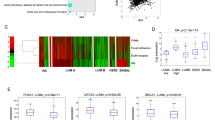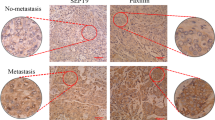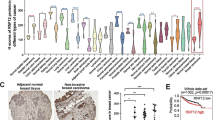Abstract
RhoA, Rac1 and Cdc42, the best-characterized members of the Rho family of small GTPases, are critical regulators of many cellular activities. Cdc42 GTPase-activating protein (CdGAP) is a serine- and proline-rich RhoGAP protein showing GAP activity against both Cdc42 and Rac1 but not RhoA. CdGAP is phosphorylated downstream of the MEK–ERK (extracellular signal-regulated kinase) pathway in response to serum and is required for normal cell spreading and polarized lamellipodia formation. In this study, we found that CdGAP protein and mRNA levels are highly increased in mammary tumor explants expressing an activated Neu/ErbB-2 (Neu-NT) receptor. In response to transforming growth factor-β (TGFβ) stimulation, Neu-NT-expressing mammary tumor explants demonstrate a clear induction in cell motility and invasion. We show that downregulation of CdGAP expression by small interfering RNA abrogates the ability of TGFβ to induce cell motility and invasion of Neu-NT-expressing mammary tumor explants. However, it has no effect on TGFβ-mediated cell adhesion on type 1 collagen and fibronectin. Interestingly, protein expression of E-Cadherin is highly increased in Neu-NT-expressing mammary tumor explants depleted of CdGAP. In addition, complete loss of E-Cadherin expression is not observed in CdGAP-depleted cells during TGFβ-mediated epithelial to mesenchymal transition. Downregulation of the CdGAP expression also decreases cell proliferation of Neu-NT-expressing mammary tumor explants independently of TGFβ. Rescue analysis using re-expression of various CdGAP deletion-mutant proteins revealed that the proline-rich domain (PRD) but not the GAP domain of CdGAP is essential to mediate TGFβ-induced cell motility and invasion. Finally, we found that TGFβ induces the expression and phosphorylation of CdGAP in mammary epithelial NMuMG cells. Taken together, these studies identify CdGAP as a novel molecular target in TGFβ signaling and implicate CdGAP as an essential component in the synergistic interaction between TGFβ and Neu/ErbB-2 signaling pathways in breast cancer cells.
This is a preview of subscription content, access via your institution
Access options
Subscribe to this journal
Receive 50 print issues and online access
$259.00 per year
only $5.18 per issue
Buy this article
- Purchase on Springer Link
- Instant access to full article PDF
Prices may be subject to local taxes which are calculated during checkout








Similar content being viewed by others
References
Bakin AV, Tomlinson AK, Bhowmick NA, Moses HL, Arteaga CL . (2000). Phosphatidylinositol 3-kinase function is required for transforming growth factor beta-mediated epithelial to mesenchymal transition and cell migration. J Biol Chem 275: 36803–36810.
Barrios-Rodiles M, Brown KR, Ozdamar B, Bose R, Liu Z, Donovan RS et al. (2005). High-throughput mapping of a dynamic signaling network in mammalian cells. Science 307: 1621–1625.
Broussard JA, Webb DJ, Kaverina I . (2008). Asymmetric focal adhesion disassembly in motile cells. Curr Opin Cell Biol 20: 85–90.
Bustelo XR, Sauzeau V, Berenjeno IM . (2007). GTP-binding proteins of the Rho/Rac family: regulation, effectors and functions in vivo. Bioessay 29: 356–370.
Carragher NO, Frame MC . (2004). Focal adhesion and actin dynamics: a place where kinases and proteases meet to promote invasion. Trends Cell Biol 14: 241–249.
Cerione RA, Zheng Y . (1996). The Dbl family of oncogenes. Curr Opin Cell Biol 8: 216–222.
Danek EI, Tcherkezian J, Meriane M, Triki I, Lamarche-Vane N . (2007). Glycogen synthase kinase-3 phosphorylates CdGAP at a consensus ERK1 regulatory site. J Biol Chem 282: 3624–3631.
Derynck R, Zhang YE . (2003). Smad-dependent and Smad-independent pathways in TGF-beta family signaling. Nature 425: 577–584.
Gómez del Pulgar T, Benitah SA, Valerón PF, Espina C, Lacal JC . (2005). Rho GTPase expression in tumorigenesis: evidence for a significant link. Bioessays 27: 602–613.
Gupta SK, Gallego C, Johnson GL . (1992). Mitogenic pathways regulated by G protein oncogenes. Mol Biol Cell 3: 123–128.
Huber MA, Kraut N, Beug H . (2005). Molecular requirements for epithelial-mesenchymal transition during tumor progression. Curr Opin Cell Biol 17: 548–558.
Jemal A, Siegel R, Ward E, Hao Y, Xu J, Murray T et al. (2008). Cancer statistics, 2008. CA Cancer J Clin 58: 71–96.
Jenna S, Hussain NK, Danek EI, Triki I, Wasiak S, McPherson PS et al. (2002). The activity of the GTPase-activating protein CdGAP is regulated by the endocytic protein intersectin. J Biol Chem 277: 6366–6373.
Jiang W, Betson M, Mulloy R, Foster R, Lévay M, Ligeti E et al. (2008). p190A RhoGAP is a glycogen synthase kinase-3-β substrate required for polarized cell migration. J Biol Chem 283: 20978–20988.
Karlsson R, Pedersen ED, Wang Z, Brakebusch C . (2009). Rho GTPase function in tumorigenesis. Biochim Biophys Acta 1796: 91–98.
Kim TY, Vigil D, Der CJ, Juliano RL . (2009). Role of DLC-1, a tumor suppressor protein with RhoGAP activity, in regulation of the cytoskeleton and cell motility. Cancer Metastasis Rev 28: 77–83.
Lalonde D, Grubinger M, Lamarche-Vane N, Turner CE . (2006). CdGAP associates with actopaxin to regulate integrin-dependent changes in cell morphology and motility. Curr Biol 16: 1–11.
Lamarche-Vane N, Hall A . (1998). CdGAP, a novel proline-rich GTPase-activating protein for Cdc42 and Rac. J Biol Chem 273: 29172–29177.
Miettinen PJ, Ebner R, Lopez AR, Derynck R . (1994). TGF-beta induced transdifferentiation of mammary epithelial cells to mesenchymal cells: involvement of type I receptors. J Cell Biol 127: 2021–2036.
Muller WJ, Sinn E, Pattengale PK, Wallace R, Leder P . (1988). Single-step inductionof mammary adenocarcinoma in transgenic mice bearing the activated c-neu oncogene. Cell 54: 105–115.
Muraoka RS, Koh Y, Roebuck LR, Sanders ME, Brantley-Sieders D, Gorska AE et al. (2003). Increased malignancy of Neu-induced mammary tumors overexpressing active transforming growth factor beta1. Mol Cell Biol 23: 8691–8703.
Muraoka-Cook RS, Dumont N, Arteaga CL . (2005). Dual role of transforming growth factor beta in mammary tumorigenesis and metastatic progression. Clin Cancer Res 11: 937S–943S.
Muraoka-Cook RS, Shin I, Yi JY, Easterly E, Barcellos-Hoff MH, Yingling JM et al. (2006). Activated type I TGFbeta receptor kinase enhances the survival of mammary epithelial cells and accelerates tumor progression. Oncogene 25: 3408–3423.
Nagaraj NS, Datta PK . (2010). Targeting the transforming growth factor-beta signaling pathway in human cancer. Expert Opin Investig Drugs 19: 77–91.
Northey JJ, Chmielecki J, Ngan E, Russo C, Annis MG, Muller WJ et al. (2008). Signaling through ShcA is required for transforming growth factor B and Neu/Erb2-induced breast cancer cell motility and invasion. Mol Cell Biol 28: 3162–3176.
Ozdamar B, Bose R, Barrios-Rodiles M, Wang HR, Zhang Y, Wrana JL . (2005). Regulation of the polarity protein Par6 by TGFbeta receptors controls epithelial cell plasticity. Science 307: 1603–1609.
Pardali E, ten Dijke P . (2009). Transforming growth factor-beta signaling and tumor angiogenesis. Front Biosci 14: 4848–4861.
Raftopoulou M, Hall A . (2004). Cell migration: Rho GTPases lead the way. Dev Biol 265: 23–32.
Siegel PM, Dankort DL, Hardy WR, Muller WJ . (1994). Novel activating mutations in the neu proto-oncogene involved in induction of mammary tumors. Mol Cell Biol 14: 7068–7077.
Siegel PM, Shu W, Cardiff RD, Muller WJ, Massagué J . (2003). Transforming growth factor beta signaling impairs Neu-induced mammary tumorigenesis while promoting pulmonary metastasis. Natl Acad Sci USA 100: 8430–8435.
Slamon DJ, Clark GM, Wong SG, Levin WJ, Ullrich A, McGuire WL . (1987). Human breast cancer: correlation of relapes and survival with amplification of the HER-2/neu oncogene. Science 235: 177–182.
Southgate L, Machado RD, Snape KM, Primeau M, Dafou D, Ruddy DM . et al. Gain-of-Function Mutations of ARHGAP31, a Rho family GTPase regulator, cause Syndromic Cutis Aplasia and Limb Anomalies. N Engl J Med (submitted).
Tcherkezian J, Danek EI, Jenna S, Triki I, Lamarche-Vane N . (2005). Extracellular signal-regulated kinase 1 interacts with and phosphorylates CdGAP at an important regulatory site. Mol Cell Biol 25: 6314–6329.
Tcherkezian J, Lamarche-Vane N . (2007). Current knowledge of the large RhoGAP family of proteins. Biol Cell 99: 67–86.
Tcherkezian J, Triki I, Stenne R, Danek EI, Lamarche-Vane N . (2006). The human orthologue of CdGAP is a phosphoprotein and a GTPase-activating protein for Cdc42 and Rac1 but not RhoA. Biol Cell 98: 445–456.
Titus B, Schwartz MA, Theodorescu D . (2005). Rho proteins in cell migration and metastasis. Crit Rev Eukaryot Gene Expr 15: 103–114.
Tomar A, Lim ST, Lim Y, Schlaepfer DD . (2009). A FAK-p120RasGAP-p190RhoGAP complex regulates polarity in migrating cells. J Cell Sci 122: 1852–1862.
Tybulewicz VL, Henderson RB . (2009). Rho family GTPases and their regulators in lymphocytes. Nat Rev Immunol 9: 630–644.
Ursini-Siegel J, Schade B, Cardiff RD, Muller WJ . (2007). Insights from transgenic mouse models of ERBB2-induced breast cancer. Nat Rev Cancer 7: 389–397.
Van Aelst L, D'Souza-Schorey C . (1997). Rho GTPases and signaling networks. Genes Dev 11: 2295–2322.
Vega FM, Ridley AJ . (2008). Rho GTPases in cancer cell biology. FEBS Lett 582: 2093–2101.
Wang SE, Wu FY, Shin I, Qu S, Arteaga CL . (2005). Transforming growth factor {beta} (TGF-{beta})-Smad targ. Mol Cell Biol 25: 4703–4715.
Wong CM, Yam JW, Ching YP, Yau TO, Leung TH, Jin DY et al. (2005). Rho GTPase-activating protein deleted in liver cancer suppresses cell proliferation and invasion in hepatocellular carcinoma. Cancer Res 65: 8861–8868.
Xue W, Krasnitz A, Lucito R, Sordella R, Vanaelst L, Cordon-Cardo C et al. (2008). DLC1 is a chromosome 8p tumor suppressor whose loss promotes hepatocellular carcinoma. Genes Dev 22: 1439–1444.
Yang YA, Dukhanina O, Tang B, Mamura M, Letterio JJ, MacGregor J et al. (2002). Lifetime exposure to a soluble TGF-beta antagonist protects mice against metastasis without adverse side effects. J Clin Invest 109: 1607–1615.
Acknowledgements
This research was supported by grants from Canadian Institute of Health Research (CIHR) MOP-84449 to NL-V and the Cancer Research Society to PMS. JJN is supported by a studentship from the Research Institute of the McGill University Health Centre. MP was a recipient of a CIHR Canada Graduate scholarship. NL-V is a recipient of a FRSQ chercheur-boursier senior. PMS is a research scientist of the Canadian Cancer Society. RDM is a British Heart Foundation Intermediate Research Fellow (BHF-FS/07/036).
Author information
Authors and Affiliations
Corresponding author
Ethics declarations
Competing interests
The authors declare no conflict of interest.
Rights and permissions
About this article
Cite this article
He, Y., Northey, J., Primeau, M. et al. CdGAP is required for transforming growth factor β- and Neu/ErbB-2-induced breast cancer cell motility and invasion. Oncogene 30, 1032–1045 (2011). https://doi.org/10.1038/onc.2010.477
Received:
Revised:
Accepted:
Published:
Issue Date:
DOI: https://doi.org/10.1038/onc.2010.477
Keywords
This article is cited by
-
CdGAP maintains podocyte function and modulates focal adhesions in a Src kinase-dependent manner
Scientific Reports (2022)
-
The emerging roles of srGAPs in cancer
Molecular Biology Reports (2022)
-
CdGAP promotes prostate cancer metastasis by regulating epithelial-to-mesenchymal transition, cell cycle progression, and apoptosis
Communications Biology (2021)
-
The scaffold protein Ajuba suppresses CdGAP activity in epithelia to maintain stable cell-cell contacts
Scientific Reports (2017)
-
Agonists and knockdown of estrogen receptor β differentially affect invasion of triple-negative breast cancer cells in vitro
BMC Cancer (2016)



